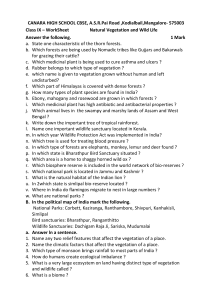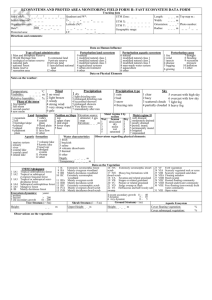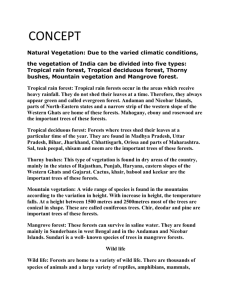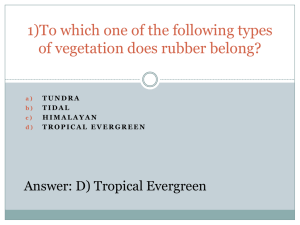Workshop on River Kali- Ecology, People and Environmental impacts
advertisement
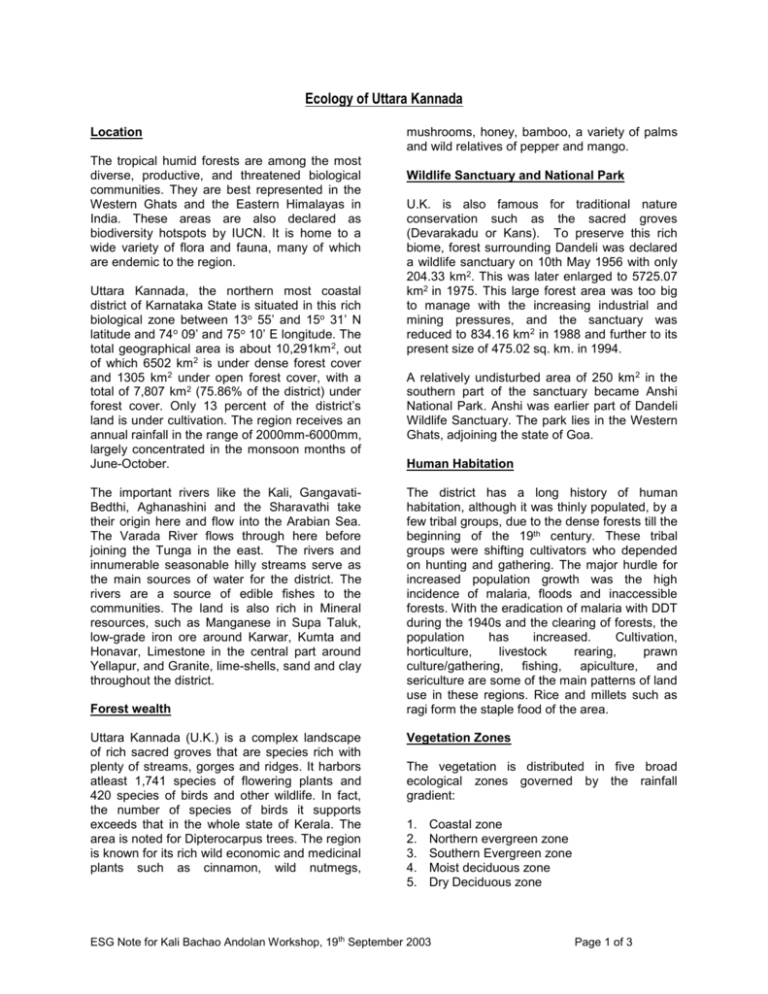
Ecology of Uttara Kannada Location The tropical humid forests are among the most diverse, productive, and threatened biological communities. They are best represented in the Western Ghats and the Eastern Himalayas in India. These areas are also declared as biodiversity hotspots by IUCN. It is home to a wide variety of flora and fauna, many of which are endemic to the region. Uttara Kannada, the northern most coastal district of Karnataka State is situated in this rich biological zone between 13o 55’ and 15o 31’ N latitude and 74o 09’ and 75o 10’ E longitude. The total geographical area is about 10,291km 2, out of which 6502 km2 is under dense forest cover and 1305 km2 under open forest cover, with a total of 7,807 km 2 (75.86% of the district) under forest cover. Only 13 percent of the district’s land is under cultivation. The region receives an annual rainfall in the range of 2000mm-6000mm, largely concentrated in the monsoon months of June-October. The important rivers like the Kali, GangavatiBedthi, Aghanashini and the Sharavathi take their origin here and flow into the Arabian Sea. The Varada River flows through here before joining the Tunga in the east. The rivers and innumerable seasonable hilly streams serve as the main sources of water for the district. The rivers are a source of edible fishes to the communities. The land is also rich in Mineral resources, such as Manganese in Supa Taluk, low-grade iron ore around Karwar, Kumta and Honavar, Limestone in the central part around Yellapur, and Granite, lime-shells, sand and clay throughout the district. Forest wealth Uttara Kannada (U.K.) is a complex landscape of rich sacred groves that are species rich with plenty of streams, gorges and ridges. It harbors atleast 1,741 species of flowering plants and 420 species of birds and other wildlife. In fact, the number of species of birds it supports exceeds that in the whole state of Kerala. The area is noted for Dipterocarpus trees. The region is known for its rich wild economic and medicinal plants such as cinnamon, wild nutmegs, mushrooms, honey, bamboo, a variety of palms and wild relatives of pepper and mango. Wildlife Sanctuary and National Park U.K. is also famous for traditional nature conservation such as the sacred groves (Devarakadu or Kans). To preserve this rich biome, forest surrounding Dandeli was declared a wildlife sanctuary on 10th May 1956 with only 204.33 km2. This was later enlarged to 5725.07 km2 in 1975. This large forest area was too big to manage with the increasing industrial and mining pressures, and the sanctuary was reduced to 834.16 km 2 in 1988 and further to its present size of 475.02 sq. km. in 1994. A relatively undisturbed area of 250 km 2 in the southern part of the sanctuary became Anshi National Park. Anshi was earlier part of Dandeli Wildlife Sanctuary. The park lies in the Western Ghats, adjoining the state of Goa. Human Habitation The district has a long history of human habitation, although it was thinly populated, by a few tribal groups, due to the dense forests till the beginning of the 19th century. These tribal groups were shifting cultivators who depended on hunting and gathering. The major hurdle for increased population growth was the high incidence of malaria, floods and inaccessible forests. With the eradication of malaria with DDT during the 1940s and the clearing of forests, the population has increased. Cultivation, horticulture, livestock rearing, prawn culture/gathering, fishing, apiculture, and sericulture are some of the main patterns of land use in these regions. Rice and millets such as ragi form the staple food of the area. Vegetation Zones The vegetation is distributed in five broad ecological zones governed by the rainfall gradient: 1. 2. 3. 4. 5. Coastal zone Northern evergreen zone Southern Evergreen zone Moist deciduous zone Dry Deciduous zone ESG Note for Kali Bachao Andolan Workshop, 19th September 2003 Page 1 of 3 The Coastal Zone is a narrow coastal strip to the west abutting the Arabian Sea with beaches, estuaries, mangrove forests and lowland evergreen forests. A major part of the land is formed by silt deposition by rivers. Hence, the soil is alluvial. The average annual rainfall is about 2800-3000mm. This zone once had one of the richest biodiversity in the world. The detritus from the mangroves played a crucial role in maintaining the food chains of the estuaries. At present, this region is highly degraded and is populated by scattered shrubs and patches of grasses in hillocks. There are few individual trees belonging to mostly fruit bearing species like Mango and Jackfruit. The mangroves are almost entirely wiped out with few small patches. The Aquatic fauna includes a variety of edible fishes in the sea and estuary. Prawns, crabs, clams, bivalves etc are common. The estuary of Aghanashini (5840 ha) is an important part of this coastal zone. A part of this estuary is used for salt production and the resultant saltpans serve to attract a large number of migrant wading birds. Two smaller estuarine areas Sunkeri (800 ha) and Thenginagundi (480 ha) also merit mention. Three important beaches, the Kamat Bay (31ha) near Karwar, Harumaskeri (90 ha) near Kumta, and Hosahitta (180ha) near Honnavar, still retain some of their vegetation. The natural vegetation of the coastal evergreens now remains in only a few patches that are protected as sacred groves, or as remnant sacred trees especially those belonging to genus Ficus. Despite high populations, the coastal zone remains as common land that is used by local people for a variety of needs, such as fuel, fodder, leaf manure, and raw materials for artisan activity. The coastal zone along with the northern and southern evergreen zones are characterized by a large number of plant species such as mango, bread fruit, nutmeg, black pepper and gingers. A part of the Northern Evergreen zone is in the Dandeli sanctuary, which also has moist deciduous forests. Although the sanctuary aimed to preserve the biota, most of the preservation is now only on paper. A major paper mill (West Coast Paper Mills) came up in 1958 inside the sanctuary and a series of hydel projects on the Kali River and its tributaries liquidated what remained of the northern evergreen and moist deciduous forests through the 1970s. Bargadda-Anishighat-Patoli (11,520 ha) and Kulgi-Virnoli (7,680 ha) blocks represents of remaining natural evergreen-semi evergreen and deciduous vegetation. The original vegetation cover of dense evergreen types is now rare and only thickets of evergreen and semi evergreen forests are found. The vegetation in the southern evergreen zone is an example of evergreen forest that is not represented in other Nature preserves. The Aghanashini Valley supports some excellent riverine habitats, including the Unchalli waterfall with a height of 100 m and its spray zone. The slopes of the Western Ghats between Aghanashini and Sharavathi valleys (7,040 ha) have a number of smaller moist valleys. This zone also harbors a unique natural habitat in the immense limestone outcrops and supports huge colonies of the rock bees. Some of the last remaining palm trees (Corypha umbraculifera) are around these rocks. This zone is also rich in sacred groves, three of which deserve a special mention: Kathlekan (91,280 ha), the sacred grove of Karikana manmane (320 ha), and that of Suremane (2,080 ha). What is striking is that even after substantial disturbance, this area retains 54 sacred groves and 45 individual sacred trees accounting for 0.31 percent of the land area. In the riverine patches originally extensive bamboo groves were found. (Campbell1883; Dharwad Gazetter1959) At present degradation has resulted mostly in scrubby vegetation with sparse growth of the original bamboo species. The soil in the plateau region is mostly brown in color and clay in texture. The Moist Deciduous Zone with its natural teak has been drastically affected by over felling, followed by conversion to teak and eucalyptus monocultures and betel nut plantations. The region is also disturbed by several reservoirs of the Kali Hydel projects. In spite of this disturbance, its remaining forests and fresh water lakes support a high level of avian species diversity. The only good patch of natural vegetation in this zone is around Gunjavati in the Mundgod– ESG Note for Kali Bachao Andolan Workshop, 19th September 2003 Page 2 of 3 Kirvatti range of the Dandeli Wildlife sanctuary (16,000 ha). This tract harbors the only resident population of wild elephants in U.K. Two fresh water lakes at Bharatnalli with the adjacent forest blocks of Yellapur in the Manchikere range (3,520 ha) and at Madura halli (15 ha) harbor rich bird fauna. The relatively flat country of the dry deciduous forest zone has been extensively brought under cultivation of millets, and more recently cotton. The soil is of two types: red loamy soil and black soil. It does not offer the possibility of large nature reserves. Three fresh water lakes, Sambrani (12 ha), Salgaum (18 ha), and Nysergi (66 ha) are rich in bird life. Conclusion: The Uttara Kannada Region has undergone major transformations over the last century in its forest cover. A variety of anthropogenic disturbances, particularly those caused by Geographic Area 10,291 infrastructure development such as mining, townships, hydel project, highways and power plants, have highly altered its vegetation mosaic. Opportunistically, colonizers have taken over the disturbed patches, with the identity of colonizers differing greatly from patch to patch. The dominant developmental thrust in U.K. has traditionally favored industrialization and all resources of forest, land, water was offered essentially free of cost. Some infrastructure developments include the paper mills, the caustic soda factory, the Kali and Sharavathi Hydel projects, the manganese and limestone mining, establishment of a nuclear plant at Kaiga, establishment of a naval base at Karwar, and the Konkan Railway. Harihar Polyfibres is quite intensively dependant on Uttara Kannada forests for its pulpwood needs. These projects have dramatically altered the habitat of this region. The impacts of such habitat destruction in such an ecologically diverse region are longterm. Forest Cover of Uttara Kannada Area in sq. kms. Dense Open Total Percent Scrub Forest Forest 6,502 1,305 7,807 75.86 1 Source: State of Forest Report 2001 References 1. Chandran M.D.S and Gadgil M State forestry and the decline in Food resources in the tropical forests of Uttara Kannada, Southern India. Man and the Biosphere series Volume 13; The Parthenon Publishing group 2. Bhattarcharyya S. and Gadgil M. J .Indian Anthrop.Soc.28: 189-212 (1993). The habitat diversity and patterns in the use of the local Natural Resource bases by Rural Populations of North –West Karnataka. 3. Singh N. and Gadgil M. Aroidaena 1996. Ecology of Amorphaphallus species in Uttara Kannada District of the Karnataka State, India: Implications for conservation 4. Gadgil M., Hegde K.M., Shetty K.A. Bhoja., Karnataka State of Environment Report1985-1986. Uttara Kannada: A case study in Hill Area Development 5. Daniels R.J.R., Chandran, M.D. S. Gadgil, M. Environmental Conservation, Vol 20 At 2. Summer 1993 A strategy for conserving the biodiversity of the Uttara Kannada District in South India. 6. Daniels, R.J.R. Gadgil, M. Joshi, N.V. Journal of Applied Ecology 1995. 32. 866-874 Impact of Human extraction on humid forests in the Western Ghats in Uttara Kannada, South India. 7. Daniels, R.J.R. Joshi, N.V. Gadgil, M. Biological Conservation 52(1990) 37-48. Changes in the Bird Fauna of Uttara Kannada, India, in Relation to changes in Land Use over the past Century. 8. Chandran, M.D.S. Gadgil, M. Mitteilungen Proceedings Forest History 1991 ‘Kans’- Safety forests of Uttara Kannada. 9. Bhat, P.R. Bhat, D.M. Ravindranath, N.H. and Gadgil, M. Int J Sustainable Development Vol 1 No.3 (69-78). Micro level planning for sustainable Development of two village ecosystems in Uttara Kannada District. 10. Bhat, L.S. Strategy for Integrated Area Development. 1988 Concept publishing Company, New Delhi Note prepared by Bhargavi S. Rao, Environment Support Group. ESG Note for Kali Bachao Andolan Workshop, 19th September 2003 Page 3 of 3


